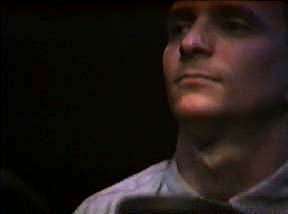
 |
![]()
![]()
![]()
021200.04

I spoke with Joshua recently and asked him about subversion and technolgy. It led to the following dialogue, which has been edited for space:
Jeff Talman: You often subvert the intended use of technology in your work, for instance your original use of headphones in Headset Sextet. As someone who thinks 'around the corners' of commercial technology design, what do you think we can look for, first in upcoming design, and second in how you personally might deal with it?
 Joshua Fried (mocking voice): What's the future of digital audio Mr. Fried and how are
you going to subvert it? (laughter) Well, that is the question. I have worked thus far
with this idea of subverting technology and in all cases this has been analog technology
where a machine has a dedicated function... where I will somehow turn upside down the
notion of a four-track. But now the computer can be a four-track or a six track or a
means to design how many number of tracks, or a means to design that means to design
it, or a programming environment to develop a programming language to develop a virtual
audio studio of your own making. How do you subvert that? And I'm not sure if I will.
I may be turning a corner artistically. In addition to subverting the four track and
the gate and the mixer, I have been using those in the service of a live performance,
where maybe I subvert the media and I try to create something very electric and of
the moment for my live performance. Maybe I will use digital technology to further
that end, and not subvert, but make it my own.
Joshua Fried (mocking voice): What's the future of digital audio Mr. Fried and how are
you going to subvert it? (laughter) Well, that is the question. I have worked thus far
with this idea of subverting technology and in all cases this has been analog technology
where a machine has a dedicated function... where I will somehow turn upside down the
notion of a four-track. But now the computer can be a four-track or a six track or a
means to design how many number of tracks, or a means to design that means to design
it, or a programming environment to develop a programming language to develop a virtual
audio studio of your own making. How do you subvert that? And I'm not sure if I will.
I may be turning a corner artistically. In addition to subverting the four track and
the gate and the mixer, I have been using those in the service of a live performance,
where maybe I subvert the media and I try to create something very electric and of
the moment for my live performance. Maybe I will use digital technology to further
that end, and not subvert, but make it my own.
I don't want to be imprisoned by the constraints of commercial software. The more feature-laden these sequencers get, the more they are laden with assumptions. So... I am designing my own (software) processing device. I will probably find myself subverting it in some ways. But I'll tell you, in designing my interface I already found myself in a situation where I couldn't help... but click the mouse when it was going to do a process on material that wasn't there yet and (so) screw up my performance. What I did was put in a software lockout, I made it impossible to tweak certain parameters until I, as the designer of the program, decided that I should be able to. Which is bizarre considering my history, I guess. It is a different world. I would love to see someone subvert the computer the way I think I've done pretty well using the analog technology. But I think such subversion will really have a different meaning because the computer isn't any one thing. It is abstractions piled and piled on abstractions.
JT: It is what you want it to be, basically.
JF: If you are a programmer and you have a lot of patience it's what you want it to be.
JT: That's the next question!
(laughter)

Copyright © 13 February 2000 Jeff Talman, Saratoga Springs, NY, USA
![]()